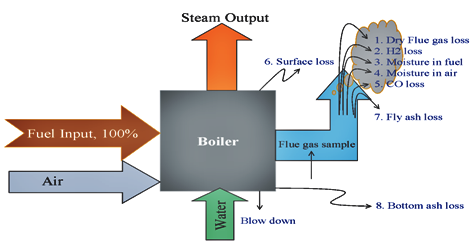You are actually paying heavily for your procratination, though you are unaware of the same. Procratination costa you heavily. Hence folllow the 9-proven steps to combat procratination.
How to Improve Energy Effciciency in Boilers

Energy Efficiency is one of the major pillars towards achieving g Net-Zero by reducing Green House Gas (GHG) emission and thereby Global Warming.
Hence it is of utmost importance that Boilers must be periodically tested for their performance assessment and compared with the design performance.
Corrective actions to be taken by implementing cleaner technologies, Fuel switching, High efficiency burners etc.
Performance of the boilers depends mainly on efficiency and evaporation ratio.
Both the above parameters diminish with time, due to following reasons:
- Improper combustion,
- Fouling of heat transfer areas
- Poor operation and maintenance (O&M) practices.
Other factors are:
- Deteriorating of fuel quality
- Boiler water quality.
Efficiency testing is the best way to find out how far the boiler efficiency deteriorated from the best efficiency point and how energy efficiency/energy performance can be improved.
Here are best ways to test boiler efficiency for performance evaluation, on-site.
Why Boiler performance test is required?
- To find out the efficiency of the boiler
- To find out the Evaporation ratio of the boiler.
What is the purpose of performance tests?
The purpose of the performance test is to determine actual performance and efficiency of the boiler and compare it with design values or norms.
Hence It is an indicator for keeping track of day-to-day and seasonal variations in boiler efficiency and energy efficiency improvements.
Procedure for Boiler performance test:
- Establish a baseline measurement. And this is the First & critical step.
- Operate the Boiler at full load for approx. 1 hour and stabilize
- Note down critical analysis data as below:
- Ultimate analysis of fuel (H2, O2, S, C, moisture content (M), ash content)
- Percentage of Oxygen or CO2 in the flue gas
- Flue gas temperature in °C (Tf)
- Ambient temperature in °C (Ta) & humidity of air in kg/kg of dry air
- GCV of fuel in KCal/kg (GCV)
- Percentage combustible in ash (in case of solid fuels)
- GCV of ash in kCal/kg (in case of solid fuels)
BOILER EFFICIENCY = (Boiler output/Boiler input)*100
= (Heat in steam output, Kcal/ Heat in Fuel input, Kcal)* 100
EVAPORTATION RATIO = Quantity of Steam Generation/ Quantity of Fuel consumption
= Kg of steam generated / Kg of Fuel spent
Standards for performance testing of Boilers:
British standards, BS845: 1987
The British Standard BS845: 1987 describes the methods and conditions under which a boiler should be tested to determine its efficiency.
Gross Calorific Value (GCV) of the fuel is used for calculation.
ASME Standard: PTC-4-1 :
Power Test Code for Steam generating Units This consists of:
Part One: Direct method (also called as Input -output method)
Part Two: Indirect method (also called as Heat loss method)
IS 8753: Indian Standard for Boiler Efficiency Testing:
Most standards for computation of boiler efficiency, including IS 8753 and BS845 are designed for spot measurement of boiler efficiency.
Hence, Boiler efficiency can be tested by the following methods:
1) The Direct Method: Where the energy gain of the working fluid (water and steam) is compared with the energy content of the boiler fuel.
2) The Indirect Method: Where the efficiency is the difference between the losses and the energy input.
Direct method is quick method for boiler efficiency calculation.
In this method, Percentage of total heat output vs heat input is calculated to establish boiler performance.
Boiler Efficiency = (Heat output / Heat Input) X 100 %
GCV = Gross calorific Value, Kcal/Kg of fuel
Indirect method of efficiency calculation is also known as heat loss efficiency calculation method.
Boiler indirect Efficiency = 100 – Losses
Standard is ASME PTC-4-1 issued for calculating boiler efficiency by indirect method.
The standards do not include blow down loss in the efficiency determination process.
In a simple way, following are the losses from a boiler
- Percentage heat loss due to dry flue gas
- Percentage heat loss due to evaporation of water formed due to H2 in fuel
- Percentage heat loss due to evaporation of moisture present in fuel (H2O)
- Percentage heat loss due to moisture present in air.(H2O)
- Loss due to Carbon Monoxide (CO)
- Loss due to surface radiation, Convection and other unaccounted losses.
- Percentage heat loss due to unburnt in fly ash (Carbon)
- Percentage heat loss due to unburnt in bottom ash (Carbon)
## losses mentioned in sl. no. 7 & 8 are specifically applicable solid fuel fired boilers in addition to the all other lossess mentioned above.
Finally, Boiler Efficiency by indirect method = 100 - Losses.
The efficiency test does not account for:
- Blow down loss: The amount of energy wasted by blow down varies over a wide range.
- Soot blower steam: The amount of steam used by soot blowers is variable that depends on the type of fuel.
- Auxiliary equipment energy consumption: The combustion efficiency test does not account for the energy usage by auxiliary equipment, such as burners, fans, and pumps.
- Standby losses: Stand by losses are the losses which occurs during firing intervals.
When the boiler is operating under a steady load then efficiency test to be carried out.
Therefore, Standby losses will not be reflecting.
FOR MORE DETAILS AND CONSULTANCY PLESAE LEAVE A COMMENT .


READ THeSe NEXT
Persons are always driven by finding happioness. But reality is neither happinees nor negetive situations, stay longer. People recover from both the situations in course of time. This is called HEDONIC ADAPTATION.
Here is a blog on Hedonic Adaptation.
Water crisis for India is loomimng large by 2025 to 20230. Not o0nly India this is going to affact whole world;s population. All nations must therefore take massive drive to sensitize all sections of people.
If not controlled, water security will be in danger.
